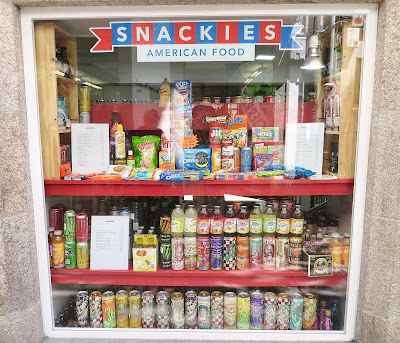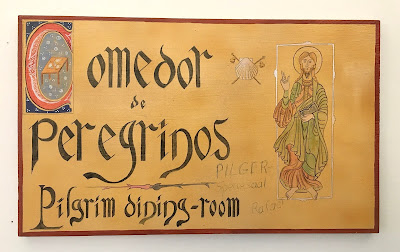The morning view as seen out the window by my bed at Seminario --
it was going to be a lovely day!
it was going to be a lovely day!
One shop displayed Galician specialties, including cone shaped cheese called Tetilla and the cake Tarta de Santiago with St. James' cross stenciled on top.
A bakery advertisement -- bread 73 cents, custard filled pastries, doughnuts, & cake.
Musicians performed near the Cathedral.
Horses leap and spout water in the Fuente de los Caballos (Fountain of the Horses) built in 1825. The fountain is in the center of Praza das Praterias, the square on the southern side of the Cathedral.
Adjacent to the Cathedral is Hostel dos Reis Catolicos, a 5-star parador and considered one of the finest hotels in the world. Paradors are state-run luxury hotels usually located in historic buildings. Hostel dos Reis' facade is in the Plateresque, or "Silversmith-like," ornate style, which became popular in Spain during the late 15th c.
The building was originally built as a pilgrims' hospice & hospital in 1486 by Queen Isabel & King Ferdinand. During the Middle Ages, "hospices" nursed sick pilgrims and "hospitals" acted as hostels where pilgrims could stay. Isabel & Ferdinand had completed the pilgrimage to Santiago & afterwards wanted to provide free support services to pilgrims.
Guidelines for the hospice/hospital written in 1524 stated that it had to accommodate and feed pilgrims for 3 nights. After the structure became a hotel in the 1950s, the tradition of feeding pilgrims remained. Thus, the hotel has provided a meal to the first 10 pilgrims who show up at 9:00, 12:00, & 7:00. I'd heard about this tradition from other walkers and wanted to experience it.
Before lunch time I inquired at the hotel's front desk where to go and was directed to find the "green door" down the street. A few other walkers had already gathered there, and soon more joined us to total 10 people. Promptly at 12:00 a man from the hotel led us down into the kitchen area where we received our food, cafeteria style.
Follow the arrows downstairs
The lunch included a delicious lentil soup, potatas, peppers, quiche, apple, and a meat patty of some sort (though didn't eat it).
There was a special dining room only for pilgrims.
Around the table were Monika from Austria on the left, then walkers from Spain, Germany, S. Korea, Czech Republic, Quebec, and Roy & Sylvia from Long Beach, California -- neighbors! Everyone had walked different routes -- the Primitivo, Portuguese, San Salvador, Norte, & Frances. The pilgrim from Germany had eaten here before on a previous pilgrimage. On this Camino he had trekked from his home in Munich & started the journey May 1.
Another experience planned for the first day in Santiago was walking half of the "Route of Routes," a tour of Santiago organized by Johnnie Walker. Johnnie works in the Pilgrims' Office and is active in Camino organizations. The route totals 8 miles and focuses on historical sites, parks, and spots where Camino paths historically enter the city. I started the route at Convento de Belvis, a site next to my albergue, Seminario Menor, which was also on the list.
Founded in the 14th c. by the Dominicans, Convento de Belvis became the first convent in Galicia. The cloistered sisters make the wafers for Santiago's churches and also sell cookies, or "biscuits," that can be purchased by ringing a buzzer next to a wooden turn style. I tried purchasing cookies at convents on previous Caminos (in Castrojeriz & Madrid) but with no luck.
I kept the boxes of cookies for gifts so didn't open them.
The next site visited was Colegiata Santa Maria a Real do Sar associated with the Augustinian order. This Romanesque church originated in the 12th c. and is situated on the Via de la Plata Camino route into the city. The structure includes interesting external buttresses shown above that were added in the 17th & 18th c. to help support the nave. Unfortunately, Colegiata do Sar was closed and the adjoining museum under renovation.
Another church on the route was Iglesia de San Francisco, not far from Santiago's public library. The church, built in the 18th c., is an immense Baroque structure. A convent associated with it was founded by St. Francis of Assisi during his visit to Santiago in 1214.
A big discovery, though, was a small chapel located near the church.
"St. Francis Santiago pilgrim"
Reliefs on a church door of St. James' crosses and perhaps his reliquary
I finished my walk of half the route by the Pilgrim's Office and then enjoyed a menu del dia at a restaurant across the street.




























No comments:
Post a Comment